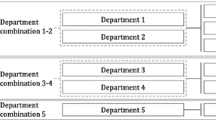Abstract
When the number of available beds in a hospital is limited, it can be beneficial to cluster several clinical departments such that the probability of not being able to admit a patient is acceptably small. However, not all clinical departments can be clustered for cross-infection reasons. In addition, patients from one clinical department should not be spread out over the entire hospital as this complicates the process of doing rounds and may result in alternate level of care. In this paper, we consider a situation where wards with a fixed number of beds are given. The question is how to cluster the clinical departments and to determine the assignment of these clustered departments to the available wards such that the assigned beds are sufficient to guarantee a blocking probability below a prespecified percentage. We first give an exact formulation of the problem to be able to achieve optimal solutions. However, computational experiments show that the resulting computation times for this model are too long for it to be applicable in practice. To reduce the computation time, we introduce two heuristic solution approaches. The first heuristic uses the same formulation as the exact model, however, the number of required beds is approximated by a linear function. The resulting model is again solved by an exact solver. The second heuristic uses a restricted version of the exact model within a local search approach. Hereby, the local search is used to determine the assignment of clinical departments to clusters and the exact model is used to determine the assignment of clusters to wards.






Similar content being viewed by others
References
Beliën J, Demeulemeester E (2007) Building cyclic master surgery schedules with leveled resulting bed occupancy. Eur J Op Res 176(2):1185–1204
de Bruin A, Bekker R, van Zanten L, Koole G (2010) Dimensioning hospital wards using the Erlang loss model. Ann Op Res 178(1):23–43
Burke EK, De Causmaecker P, Van Landeghem H (2004) J Sched 7(6):441–499
Dantzig GB, Wolfe P (1960) Decomposition principle for linear programs. Op Res 8(1):101–111
van Essen JT, Bosch JM, Hans EW, van Houdenhoven M, Hurink JL (2013) Reducing the number of required beds by rearranging the OR-schedule. OR Spectr 1–21. doi:10.1007/s00291-013-0323-x
Garey MR, Johnson DS (1979) Computers and intractability: a guide to the theory of NP-completeness. W. H. Freeman & Co Ltd., New York
Gorunescu F, McClean SI, Millard PH (2002) A queueing model for bed-occupancy management and planning of hospitals. J Op Res Soc 53(1):19–24
Gorunescu F, McClean SI, Millard PH (2002) Using a queueing model to help plan bed allocation in a department of geriatric medicine. Health Care Manag Sci 5(4):307–312
Green LV, Nguyen V (2001) Strategies for cutting hospital beds: the impact on patient service. Health Serv Res 36(2):421–442
Harper PR, Shahani AK (2002) Modelling for the planning and management of bed capacities in hospitals. J Op Res Soc 53(1):11–18
Kokangul A (2008) A combination of deterministic and stochastic approaches to optimize bed capacity in a hospital unit. Comput Methods Progr Biomed 90(1):56–65
Lapierre SD, Goldsman D, Cochran R, DuBow J (1999) Bed allocation techniques based on census data. Socio-Econ Plan Sci 33(1):25–38
Li X, Beullens P, Jones D, Tamiz M (2009) An integrated queuing and multi-objective bed allocation model with application to a hospital in China. J Op Res Soc 60(3):330–338
Qiao S, Qiao L (1998) A robust and efficient algorithm for evaluating Erlang b formula. Technical report
Shakhov V (2010) Simple approximation for Erlang b formula. In: Proceedings of 2010 IEEE Region 8th international conference on computational technologies in electrical and electronics engineering (SIBIRCON), pp 220–222
Sherali HD, Smith JC (2001) Improving discrete model representations via symmetry considerations. Manag Sci 47(10):1396–1407
Tijms HC (2003) A first course in stochastic models. Wiley, Chichester
Utley M, Gallivan S, Treasure T, Valencia O (2003) Analytical methods for calculating the capacity required to operate an effective booked admissions policy for elective inpatient services. Health Care Manag Sci 6(2):97–104
Vanberkel PT, Boucherie RJ, Hans EW, Hurink JL, van Lent WAM, van Harten WH (2011) An exact approach for relating recovering surgical patient workload to the master surgical schedule. J Op Res Soc 62(10):1851–1860
Williams HP (1999) Model building in mathematical programming. Wiley, Hoboken
Acknowledgments
This research is supported by the Dutch Technology Foundation STW, applied science division of NWO and the Technology Program of the Ministry of Economic Affairs. We would like to thank the anonymous referees and Erwin Hans for their useful comments which helped to improve the paper.
Author information
Authors and Affiliations
Corresponding author
Rights and permissions
About this article
Cite this article
van Essen, J.T., van Houdenhoven, M. & Hurink, J.L. Clustering clinical departments for wards to achieve a prespecified blocking probability. OR Spectrum 37, 243–271 (2015). https://doi.org/10.1007/s00291-014-0368-5
Published:
Issue Date:
DOI: https://doi.org/10.1007/s00291-014-0368-5




